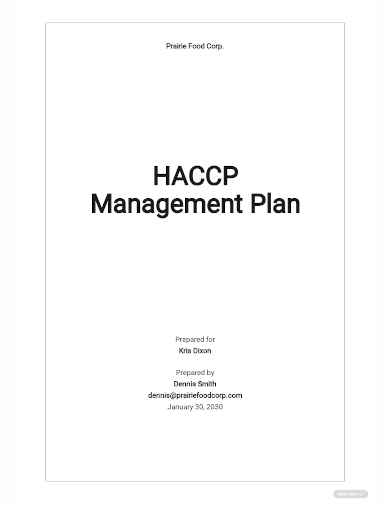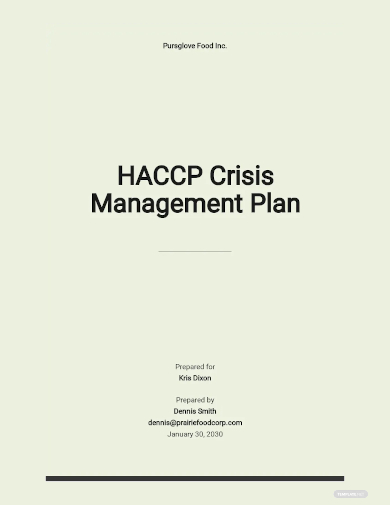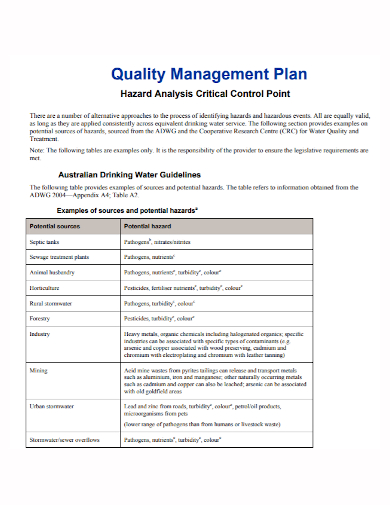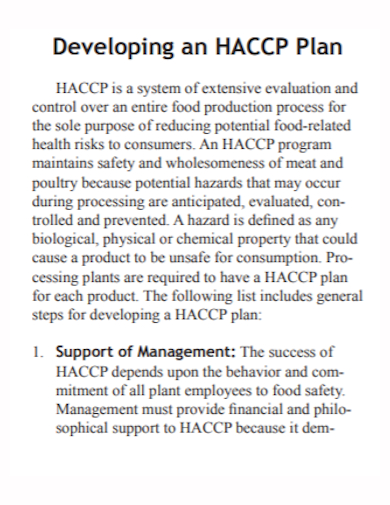For businesses that process food products, they must make sure that their products are safe for human consumption even while going through different processes such as developing the product, storing, distributing, and selling them. If they aren’t careful, they have the risk of endangering the health and safety of their consumers and this risk can jeopardize their business. That’s why a HACCP management plan is essential to maintain the safety standards of food processing. Read the article to know how to make the plan.
3+ HACCP Management Plan Samples
1. HACCP Management Plan Template

2. HACCP Crisis Management Plan Template

3. HACCP Quality Management Plan
4. HACCP Management Development Plan
What is a HACCP Plan?
A hazard analysis critical control points (HACCP) plan is used as a food safety monitoring system to identify and manage all biological, chemical, and physical hazards and the critical control points that perishable goods are at risk of within the process of storing, transporting, preparing, and selling.
How to Make a HACCP Management Plan
1. Write Your Product Description
The first thing to do is to write the description of every product. The description must include the following information:
- Name of the food
- Ingredients
- Processing methods
- Packaging
- Storage
- Distribution procedures
- Label and labeling information
The next part of the product description is to give an explanation of the intended use of the product and the types of people who will purchase them. If they are niche-type products, provide more specific information on how to consume them. This part is important to know the critical limits of the products later.
2. Develop the Commodity Flow Chart
The next section of the plan is to identify the scope and the process or commodity flow. Include a process chart or a flow diagram with the following information that should be included:
- Inputs from the product
- Intended delays
- Procedures that vary by season
- Return of product to the process
- Outputs from the product
Don’t forget to verify the flow diagram by visiting the sites in which the whole process takes place and examining each step during the production process. This will ensure that all processes and materials used are accurate to help you identify the control points in the next steps. If there are any changes in the processes, review the process once again and update the plan to make sure your flow diagram includes the complete process.
3. Conduct a Hazard Analysis
Once your flow diagram is complete, include your hazard assessment. The evaluation must identify each potential biological, chemical, and/or environmental hazard in every step in your flow diagram. Describe the hazard type, the likelihood that it will happen, and the control methods and any other legal requirements to mitigate those hazards. This will help you be aware of which steps are critical to protecting your consumers from risks.
4. Identify the Critical Control Points
Once you’ve identified hazards, it’s time to identify the critical control points (CCPs) for each process step. These points will help you identify how you can intervene a hazard from happening to an acceptable critical limit for food safety.
If the points fall way beyond the critical limit, then the product that undergoes that certain process faces a great risk to the health of your consumers. Make sure you fill in the critical limits column with measurable controls. Just like the hazard assessment, you need to verify and monitor the critical limits as well as the corrective actions that have been done to spur them from getting out of hand.
5. Identify the Monitoring Procedures
To make sure the CCP is under control and does not go beyond the critical limit where it loses control and allows you to take corrective actions as well, you need to explain comprehensively your monitoring procedures. The monitoring procedures must have the following information:
- The person assigned to conduct the monitoring process
- What to monitor
- The process for monitoring
- Process timeline
- The person assigned to audit the monitoring process
Document all of the monitoring procedures in the monitoring columns of your HACCP plan.
6. Include the Corrective Actions for Each CCP
The corrective actions are important to include in the management plan to restore control, deal with the impact if there is a loss of control, and investigate the cause of the loss of control. This section must determine your corrective actions for CCPs and note down the person who is responsible to conduct the corrective action and the person who will audit the corrective action procedure.
7. Validate and Verify the Plan
Before you finalize your HACCP management plan, validate and verify the plan by going through the checking process on-site by an individual outside the daily monitoring and data collection team. You also need to validate all the scientific and technical aspects of the processes, especially the ones that identify the hazards.
Don’t forget to record all the activities associated with your HACCP plans such as critical limit monitoring log, testing, and calibration log, corrective action log, and verification log. Make sure you have a comprehensive document and recordkeeping of these logs.
FAQs
How long is the validity of a HACCP plan?
HACCP plans are valid for five years if there are no changes that have been made and if the regulations have changed the impact of the process.
Who is required to have a HACCP plan?
All food processing businesses must have a HACCP plan to determine the different risks that the food may get contaminated with and figure out the risk management practices to mitigate those risks.
When should a HACCP plan be checked?
Once the HACCP plan is implemented, it’s crucial to review them at least once a year and when there are any changes in the production.
When writing your HACCP plan make sure that all descriptions are accurate, straightforward, and brief. It’s important to use simple vocabulary as well for your plan to be easily understood and followed. Review your plan and revise any spelling and grammatical mistakes and remove unnecessary information. To help you get started making a HACCP management plan, download our free sample templates above to use as your guide!
Related Posts
FREE 10+ Operations Management Plan Templates in PDF
FREE 17+ Construction Management Plan Samples in PDF Google ...
FREE 8+ Sample Behavior Management Plan Templates in MS ...
FREE 15+ Sample Project Management Plan Templates in MS Word ...
FREE 9+ Crisis Plan Samples in PDF MS Word
FREE 4+ Sample Configuration Management Plan Templates in PDF
FREE 8+ Sample Risk Management Plan Templates in MS Word PDF
FREE 13+ Communication Management Plan Samples in PDF MS ...
FREE 9+ Sample Risk Management Plan Templates in PDF MS Word
FREE 7+ Chronic Disease Management Plan Samples in PDF DOC
FREE 12+ Sample Classroom Management Plan Templates in PDF ...
FREE 9+ Sample Quality Management Plan Templates in MS Word ...
FREE 10+ Project Quality Management Plan Samples [ Construction ...
FREE 10+ Construction Safety Management Plan Samples [ Road ...
FREE 7+ Sample Time Management in MS Word PDF


